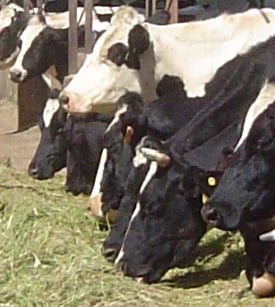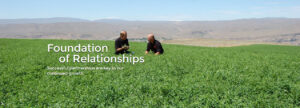High-producing dairy cows must be fed an energy-dense diet in order to meet requirements for milk production. An energy-dense diet typically contains easily fermented carbohydrates (starches and sugars). This type of diet must also contain a suitable level of roughage to uphold rumen health and functionality, allow adequate dry matter intake, sustain milk production and milk composition, and decrease susceptibility to metabolic disorders such as sub-acute ruminal acidosis (SARA). The metabolic disorder SARA typically affects cows in early to mid-lactation that are consuming highly-fermentable diets. Consumption of large quantities of this type of diet causes ruminal pH to drop, which subsequently suppresses fiber digestion and leads to lower butterfat production. In addition, low ruminal pH can lead to inflammation of rumen epithelium (tissue that lines the rumen) and ulceration. Cows with SARA may have diarrhea and sore hooves (laminitis). In advanced cases of SARA, bacteria grow on the inflamed ruminal papillae and eventually leak into blood vessels that flow into the liver, which results in liver abscesses (1).
U.S. dairy farmers lose between $500 million and $1 billion every year due to complications from SARA (1), so it is easy to understand why diets must be balanced to contain enough fiber to minimize the risk of developing this metabolic disorder. Fiber content of dairy cow diets can be increased by replacing some of the concentrate with high-quality forages without affecting digestible energy intake or subsequent milk production. This practice may also decrease production costs associated with feed. But, too much fiber can decrease a dairy cow’s feed intake, which would be detrimental to milk production. Therefore, it is important to provide the correct balance between fiber and fermentable carbohydrates in high-producing dairy cow diets.
So far, finding the perfect balance between fiber and fermentable carbohydrates has proven difficult. Typically, a diet that contains 40 – 45% forage dry matter is sufficient to maintain intake (2). But, scientists have determined that physically effective neutral detergent fiber (peNDF), a measure that combines both chemical fiber composition and feed particle size, may be a more effective way to assess adequacy of dietary fiber in high-producing dairy cow diets(3). Diets that contain a peNDF content of 30 – 32% with particle sizes greater than 1.18 mm (0.05 in) are sufficient in maintaining optimal rumen pH and reducing the risk of SARA (3). In addition, offering feed in a way that dairy cows have continuous access to small, frequent meals may also prevent SARA. In conclusion, including adequate amounts of high-quality forage in energy-dense diets is important to support milk production and maintain health in high-producing dairy cows.
Do you have a good feeding plan in place for your dairy? Share your recipe for healthy cows in the comment section.
To recieve these blog posts via email, please subscribe in the box to the upper right.
References
(1) Krause, K.M. and G.R. Oetzel. 2006. Understanding and preventing subacute ruminal acidosis in dairy herds: A review. Anim. Feed Sci. Technol. 126:215-236.
(2) National Research Council, 2001. Nutrient requirements of dairy cattle, 7th edition. National Academy Press, Washington, D.C.
(3) Zebeli, Q., D. Mansmann, H. Steingass, and B.N. Ametaj. 2010. Balancing diets for physically effective fibre and ruminally degradable starch: A key to lower the risk of sub-acute rumen acidosis and improve productivity of dairy cattle. Livestock Sci. 127:1-10.


